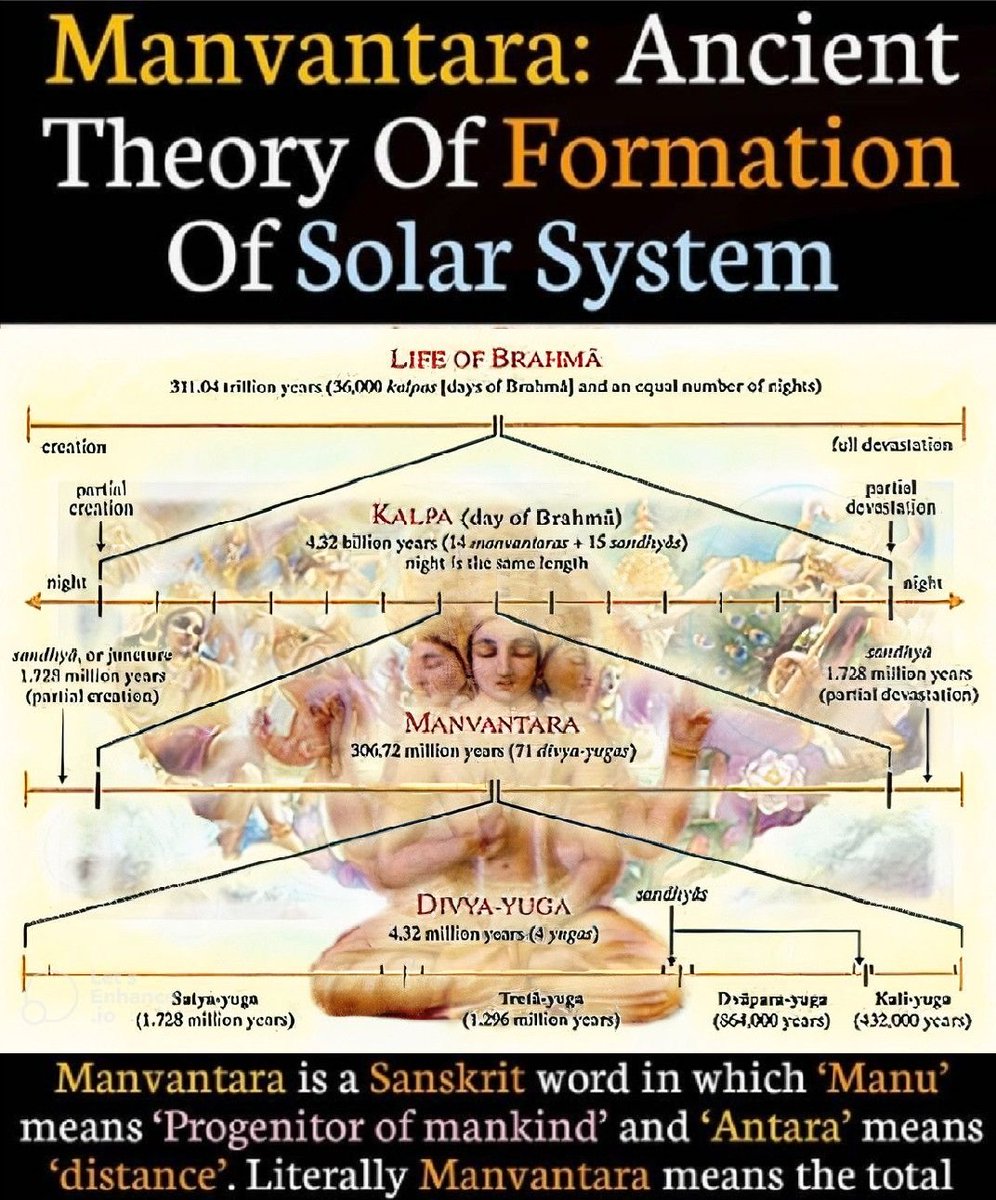Manvantara-Ancient Hindu Theory of Time & Solar System.
Sanatana Dharma doesn’t just speak of Gods & rituals… it maps the cosmic cycles of creation & dissolution with stunning precision.
🧵#Thread Let’s decode the concept of Manvantara.👇
Sanatana Dharma doesn’t just speak of Gods & rituals… it maps the cosmic cycles of creation & dissolution with stunning precision.
🧵#Thread Let’s decode the concept of Manvantara.👇

1. Life of Brahma
A single Brahma (cosmic creator) lives 311.04 trillion years.
His lifespan is divided into 36,000 Kalpas (days) and equal nights.
Each day & night witnesses creation and dissolution.
A single Brahma (cosmic creator) lives 311.04 trillion years.
His lifespan is divided into 36,000 Kalpas (days) and equal nights.
Each day & night witnesses creation and dissolution.
2. Kalpa – A Day of Brahma
One Kalpa = 4.32 billion years.
It includes:
14 Manvantaras
15 Sandhyas (junctures, each ~1.728 million years).
Kalpa: the scale on which worlds are born & destroyed.
One Kalpa = 4.32 billion years.
It includes:
14 Manvantaras
15 Sandhyas (junctures, each ~1.728 million years).
Kalpa: the scale on which worlds are born & destroyed.
3. Manvantara – Rule of a Manu
Duration: 306.72 million years.
Each ruled by a Manu, the progenitor of mankind.
One Manvantara includes 71 Mahayugas (Divya-Yugas).
Etymology:
Manu = progenitor of mankind
Antara = interval
Manvantara = "Interval of a Manu"
Duration: 306.72 million years.
Each ruled by a Manu, the progenitor of mankind.
One Manvantara includes 71 Mahayugas (Divya-Yugas).
Etymology:
Manu = progenitor of mankind
Antara = interval
Manvantara = "Interval of a Manu"
4. Divya-Yuga / Maha-Yuga
One cycle of 4 Yugas = 4.32 million years:
Satya Yuga (1.728m yrs) – Age of Truth
Treta Yuga (1.296m yrs) – Age of Sacrifice
Dwapara Yuga (864k yrs) – Age of Duality
Kali Yuga (432k yrs) – Present Age of Darkness
One cycle of 4 Yugas = 4.32 million years:
Satya Yuga (1.728m yrs) – Age of Truth
Treta Yuga (1.296m yrs) – Age of Sacrifice
Dwapara Yuga (864k yrs) – Age of Duality
Kali Yuga (432k yrs) – Present Age of Darkness
5. The Stunning Parallel
Modern science estimates the Earth to be 4.54 billion years old.
Hindu cosmology speaks of Kalpa = 4.32 billion years – astonishingly close!
Is this coincidence, or ancient seers’ deep cosmic vision?
Modern science estimates the Earth to be 4.54 billion years old.
Hindu cosmology speaks of Kalpa = 4.32 billion years – astonishingly close!
Is this coincidence, or ancient seers’ deep cosmic vision?
6. Sanatana Dharma teaches:
Creation is cyclic, not linear.
Universes rise & dissolve endlessly.
Time is infinite, and so is the Self.
We are not just living in time we are time itself.
If you’re amazed by this ancient wisdom:
🔁 Repost this to spread Sanatana Knowledge.
🤝 Follow @_SanatanDharma for more cosmic Hindu insights.
Creation is cyclic, not linear.
Universes rise & dissolve endlessly.
Time is infinite, and so is the Self.
We are not just living in time we are time itself.
If you’re amazed by this ancient wisdom:
🔁 Repost this to spread Sanatana Knowledge.
🤝 Follow @_SanatanDharma for more cosmic Hindu insights.
• • •
Missing some Tweet in this thread? You can try to
force a refresh










